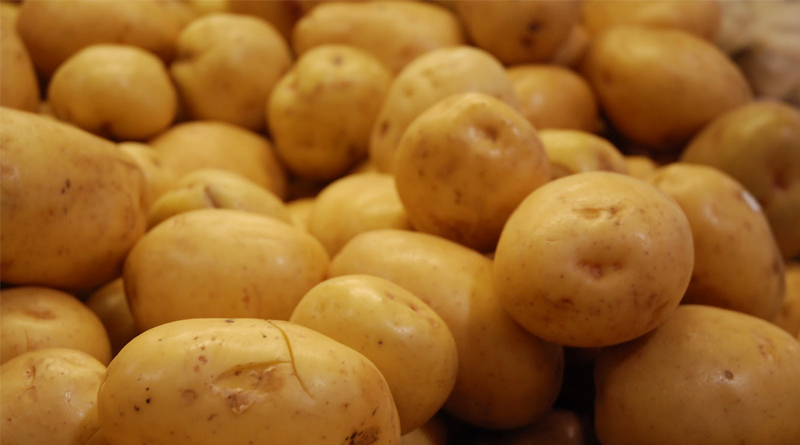Austrian-headquartered starch supplier Agrana has innovated with the launch of a new organic potato fiber solution, to meet technical and health demands. At HiE 2018, which finishes today in Frankfurt, the company is presenting Agenafiber amid the strong rise of a high fiber fortification trend. Due to its well-developed water-binding properties and texturizing characteristics the insoluble fiber offers a lot of various additional benefits in food products, including meat alternatives.
Other innovative ingredient solutions being presented by the company include a functional maltodextrin for sports performance products with a low glycemic index (Agenova) and a vegan/organic egg substitute based on a blend of wheat and corn (Agenovum).
Agrana as a whole is divided into three segments (Sugar, Starch and Fruit). “We produce sugar from sugar beet. Our most global division of fruit preparations offers semi-finished fruit products for dairy, ice cream and bakery [fruit fillings]. The Agrana starch division is processing and refining top-quality corn, wheat and potatoes to create a variety of different, highly refined starch and special starch products (e.g. organic and GMO-free starch),” explains Leopold Schönauer, Product Manager at Agrana Starch tells FoodIngredientsFirst.
Oliver Berger, Sales Director Food & Ethanol stresses that Agrana is the world leader in organic starches. “Agrana sets a strong focus on organic which has a strong growth rate in the past year Austria through our heritage in having organic farmers. It is a global business and not limited by geography, however,” he explains.
One of the challenges facing the potato starch segment in Europe this year has been the record-breaking summer droughts. While Berger accepted that Agrana has been impacted, with a very poor potato harvest, he noted that the impact in Austria was smaller than that felt by northern European growers. “We have also been hit with potato products and potato starch that did not get the fully contracted harvest. It was not as bad as the north of Europe but it was still bad,” he noted.
For Schönauer, the company’s global player position, but relatively small structure means that it is easier to offer tailored and organic products. This background has led to the launch of the company’s first potato fiber solution. Should the organic launch prove successful, a conventional agriculture product is a possibility.
Due to its well-developed water-binding properties and texturizing characteristics, the insoluble fiber offers a lot of various additional benefits, when adding fiber into food products for fiber enrichment, including meat alternatives.
“We are going to start on potato fiber by end of this year, where we focus on organic. The main applications are in bakery, where it is used for fiber enrichment and as well to have positive side effects thereof, like avoiding staling, bind water and reduce retrogradation in bakery products,” he notes.
“When producing meat alternatives, you usually need to use a lot of modified ingredients. Here this ingredient can target these niche products to go onto more natural and organic meat alternatives, to add fiber and body and bind water on top.”
“This is all stuff that has been conventionally available for a long time, however, if you really want to go for natural products, which go in line with the vegan trend, this ingredient makes absolute sense to close this gap,” he adds.
“We are going to start producing potato fiber at the end of this year, where we focus on organic. The main applications are bakery, where it can be used for fiber enrichment and to have technological benefits to avoid staling, bind water and reduce retrogradation in bakery products,” he notes.
Interestingly, one of the other key potential applications is the meat alternatives space. Consumers within this ballooning segment often demand clean label products but can be held back by the long ingredient lists that typically accompany them. Food formulators are challenged to bring body and water-binding properties to products largely composed of popular vegetable proteins such as soy, wheat and pea protein while maintaining clean labels. “With meat alternatives, you usually need to use a lot of modified ingredients. Here this ingredient can target these niche products to go onto organic meat alternatives, to add body and bind water,” Schönauer explains.
Agenafiber could be used to replace other fibers, modified starches, cellulose fibers and hydrocolloids. “This is all stuff that has been conventionally available for a long time. But if you really want to go for natural products, which go in line with the vegan trend, this makes sense. It could be used to replace several ingredients that would typically have been used in a blend,” he adds.
The list of potential applications for the ingredient is long: Bakery, Bread & Cakes, Breakfast Cereals & Cereal Bars, Crackers & Biscuits, Processed Meat & Sausages, Pizza, Tortilla & Wraps, Pasta & Potato Puree, Soups & Sauces Smoothies & Instant Drinks, Pet Food and Animal Feed.
Several advantages are listed for the ingredient:
High fiber content claim on the label
Retains moisture and slows staling
Product softness & Mouthfeel enhancement
Increases shelf-life
Texture improvement notably in low-fat products
Stabilization of particles in liquids
Fast food upgrading
Also from Agrana and presented at this year’s HiE New Product Zone is Agenova, a complex carbohydrate source for sports nutrition. “This product is an approach to allow the producers of sports nutrition to use a new kind of maltodextrin or soluble starch to produce energy gels or mass gainers in a more sustainable and consistent way,” explains Berger. This product is more complex in structure and less insulin active. So you have a really constant source of energy during your exercise when compared to dextrose or other maltodextrins,” he adds.
Maltodextrin in sports nutrition products typically offers a sharp peak of energy followed by a quick crash. Agrana’s new solution allows sports performers to be more energized after exercise. “In the case of dextrose, it will take 45-60 minutes before you get back to your initial level or under you initial blood sugar level. With Agenova you can extend this time to more than 90 minutes. You don’t have this crash and just settle on your baseline blood sugar level,” Berger notes. The product is suitable for energy gels, where it is neutral in taste and doesn’t upset the stomach. The product has less of a starch taste too and is also not turbid, which means that it remains clear. “It can be used in powder form too, where it could be used in muesli bars, for example. It is an alternative for maltodextrin to have a less sweet option for these producers. Even highly skilled athletes are looking for healthy alternatives,” Schönauer adds.
“It can be used as an adhesive component too, usually in muesli bars, power bars or savory like bars, for example. It is an alternative for maltodextrin to have a less sweet option for these producers. Even highly skilled athletes are looking for healthy alternatives,” he adds.
This product is an approach to allow the producers of sports nutrition to use a new kind of maltodextrin or soluble starch to produce energy gels or mass gainers in a more sustainable and consistent way,” explains Schönauer.
Also at HiE 2018, the company is presenting a vegan egg replacer. The powdered product can be immersed in water and then used like every other liquid egg product, mainly for bakery applications: waffles, biscuits, cookies, cakes etc. Agenovum is based on a mixture of several Agrana ingredients. “One is mainly based on wheat protein, while another is a gluten-free option based on pregelatinized chickpea flour, which is a unique product for us, for instant hummus and spreads,” says Schönauer.
The product can have an ethical positioning to address the demands of vegan consumers who do not eat eggs. But there is also an advantage of being able to reduce the costs of bakery products significantly, due to the fact that egg prices are volatile. “At current price levels, this solution could save about 12-20 percent on egg prices, depending on whether you are using egg powder or liquid egg, or the market you are producing,” Berger notes.
New consumer market demands, coupled with business dynamics mean that value-added starch products can hold potential in entirely new ways. These can include addressing organic and vegan demands, as well as performing from a cost reduction perspective.
Source: Food Ingredients First







